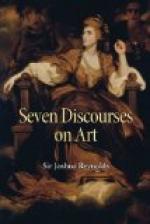The directors ought more particularly to watch over the genius of those students who, being more advanced, are arrived at that critical period of study, on the nice management of which their future turn of taste depends. At that age it is natural for them to be more captivated with what is brilliant than with what is solid, and to prefer splendid negligence to painful and humiliating exactness.
A facility in composing, a lively, and what is called a masterly handling the chalk or pencil, are, it must be confessed, captivating qualities to young minds, and become of course the objects of their ambition. They endeavour to imitate those dazzling excellences, which they will find no great labour in attaining. After much time spent in these frivolous pursuits, the difficulty will be to retreat; but it will be then too late; and there is scarce an instance of return to scrupulous labour after the mind has been debauched and deceived by this fallacious mastery.
By this useless industry they are excluded from all power of advancing in real excellence. Whilst boys, they are arrived at their utmost perfection; they have taken the shadow for the substance; and make that mechanical facility the chief excellence of the art, which is only an ornament, and of the merit of which few but painters themselves are judges.
This seems to me to be one of the most dangerous sources of corruption; and I speak of it from experience, not as an error which may possibly happen, but which has actually infected all foreign academies. The directors were probably pleased with this premature dexterity in their pupils, and praised their despatch at the expense of their correctness.
But young men have not only this frivolous ambition of being thought masterly inciting them on one hand, but also their natural sloth tempting them on the other. They are terrified at the prospect before them, of the toil required to attain exactness. The impetuosity of youth is distrusted at the slow approaches of a regular siege, and desires, from mere impatience of labour, to take the citadel by storm. They wish to find some shorter path to excellence, and hope to obtain the reward of eminence by other means than those which the indispensable rules of art have prescribed. They must, therefore, be told again and again that labour is the only price of solid fame, and that whatever their force of genius may be, there is no easy method of becoming a good painter.
When we read the lives of the most eminent painters, every page informs us that no part of their time was spent in dissipation. Even an increase of fame served only to augment their industry. To be convinced with what persevering assiduity they pursued their studies, we need only reflect on their method of proceeding in their most celebrated works. When they conceived a subject, they first made a variety of sketches; then a finished drawing of the whole; after that a more correct drawing of every separate part, heads, hands, feet, and pieces of drapery; they then painted the picture, and after all re-touched it from the life. The pictures, thus wrought with such pain, now appear like the effect of enchantment, and as if some mighty genius had struck them off at a blow.




